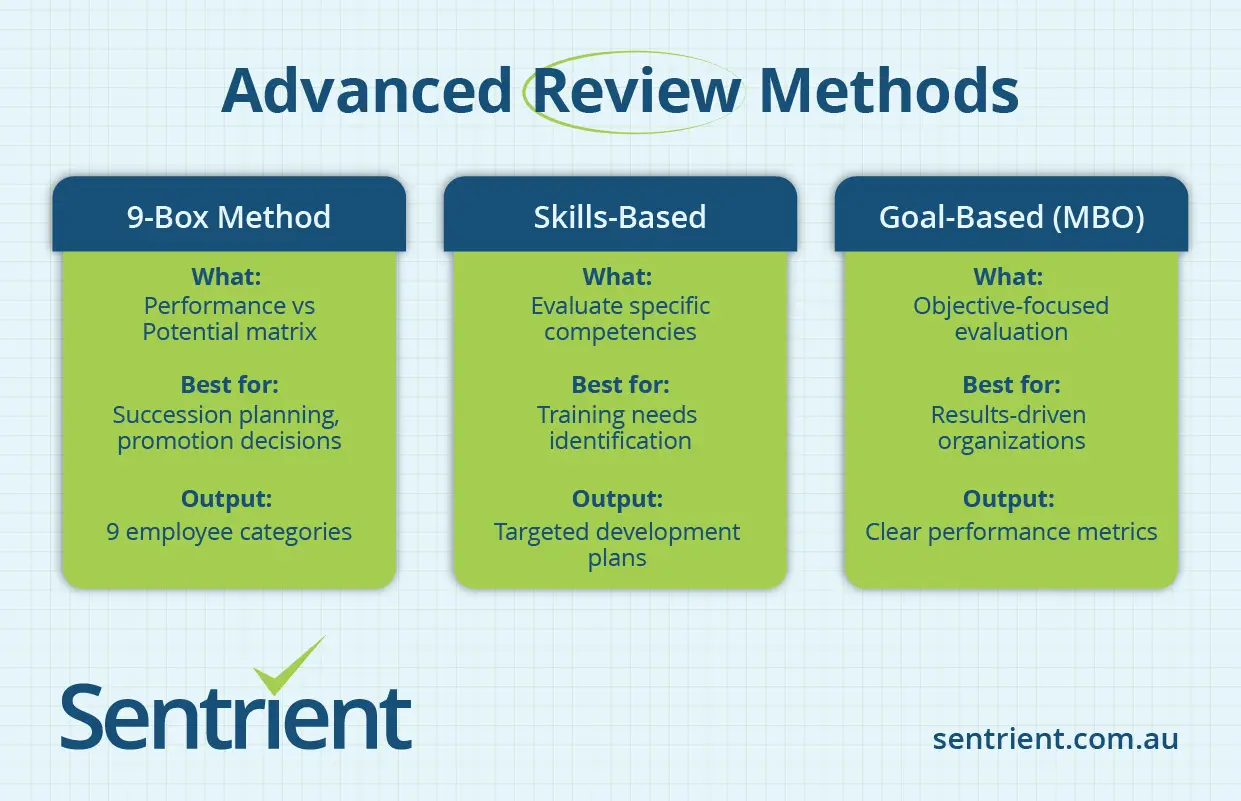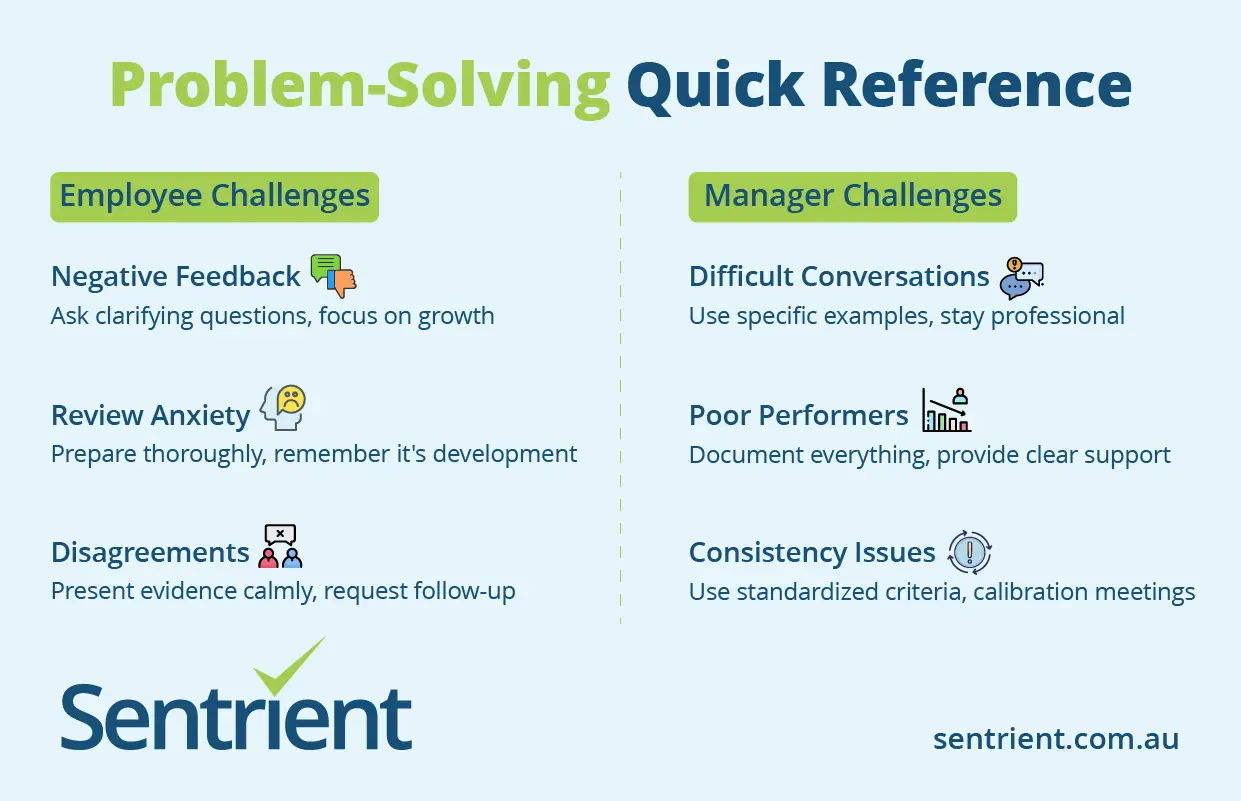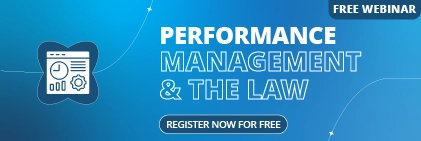Performance reviews shouldn’t feel like a dreaded annual event that everyone wants to avoid. When done properly, they’re powerful tools that help employees grow, managers lead better, and businesses succeed. Whether you’re an employee preparing for your first review or a manager looking to improve your approach, this comprehensive guide will transform how you think about performance evaluations.
At Sentrient, we’ve helped over 600 Australian and New Zealand businesses streamline their HR processes, and we’ve seen firsthand how effective performance reviews can revolutionise workplace culture and productivity.
What Are Performance Reviews?
A performance review is a structured conversation between an employee and their manager to evaluate work performance, discuss achievements, identify areas for improvement, and set future goals. Unlike casual check-ins or feedback sessions, performance reviews are formal, documented processes that typically occur at regular intervals.
Performance reviews serve multiple purposes: they provide employees with clear feedback on their work, help managers identify training needs and promotion opportunities, and give organisations valuable data for making informed decisions about compensation, career development, and workforce planning.
The key difference between performance reviews and regular feedback is the systematic approach. Reviews follow a structured format, involve formal documentation, and often tie directly to compensation decisions and career advancement opportunities.
Types of Performance Reviews You Should Know
Basic Review Types
1. Manager-to-Employee Reviews (Traditional Reviews)
The most common type where direct supervisors evaluate their team members’ performance. These reviews focus on job-specific criteria, goal achievement, and overall contribution to the team.
2. Self-Evaluation Reviews
Employees assess their own performance using the same criteria their managers use. Self-evaluations encourage self-reflection and often reveal insights that managers might miss.
3. 360-Degree Feedback
Comprehensive reviews that gather input from supervisors, peers, subordinates, and sometimes external clients. This approach provides a well-rounded view of an employee’s performance and interpersonal skills.
4. Team Performance Reviews
Evaluate collective team performance rather than individual contributions. These reviews focus on collaboration, team goals, and group dynamics.
How Often Reviews Happen
1. Weekly Check-ins vs Annual Reviews
Weekly check-ins work well for new employees or those on improvement plans, whilst annual reviews provide comprehensive evaluation and goal-setting opportunities.
2. Monthly and Quarterly Options
Monthly reviews suit fast-paced environments, whilst quarterly reviews balance regular feedback with manageable workload for managers.
3. Which Frequency Works Best
Most successful organisations combine regular check-ins with formal quarterly or bi-annual reviews, ensuring continuous communication without overwhelming administrative burden.
How Performance Reviews Actually Work
Before the Review Meeting
1. What Managers Need to Prepare:
- Review employee’s job description and previous goals
- Gather specific examples of performance (both positive and areas for improvement)
- Collect feedback from relevant colleagues
- Prepare discussion points about career development
- Research potential training opportunities or resources
2. How Employees Should Get Ready:
- Document achievements and completed projects
- Prepare examples of challenges overcome
- Identify skills you’d like to develop
- Think about your career goals
- Prepare questions about company direction and opportunities
Gathering Feedback and Examples
Use performance management systems to track ongoing feedback throughout the review period. This approach ensures reviews are comprehensive rather than based on recent events only.
During the Review Meeting
1. Setting Up a Comfortable Conversation
Choose a private, comfortable space and allow adequate time. Start with positive achievements to create a constructive atmosphere before addressing areas for improvement.
2. How to Give and Receive Feedback
Focus on specific behaviours and outcomes rather than personality traits. Use the “SBI” model: Situation, Behaviour, Impact to structure feedback clearly.
3. Making It a Two-Way Discussion
Encourage questions and discussion. The best reviews feel like collaborative conversations rather than one-sided evaluations.
After the Review Meeting
1. Creating Action Plans
Document specific steps for improvement or development, including timelines and resources needed. Clear action plans turn feedback into measurable progress.
2. Setting New Goals
Establish SMART goals (Specific, Measurable, Achievable, Relevant, Time-bound) that align with both individual aspirations and organisational objectives.
3. Following Up on Progress
Schedule regular check-ins to monitor progress on action plans and goals. This ongoing support increases the likelihood of successful outcomes.
Employee Guide: How to Succeed in Your Performance Review
How to Prepare Like a Pro
1. Collecting Your Wins and Achievements:
- Keep a running record of accomplishments throughout the year
- Quantify results wherever possible (percentages, numbers, time saved)
- Include both big projects and smaller daily contributions
- Note positive feedback received from colleagues or clients
2. Being Honest About Areas to Improve:
Self-awareness demonstrates maturity and growth mindset. Identify 2-3 specific areas where you’d like to develop and come prepared with ideas for improvement.
3. Preparing Smart Questions to Ask:
- “What skills should I focus on developing for career advancement?”
- “How can I better support team goals?”
- “What opportunities exist for additional responsibilities?”
During Your Review Meeting
1. How to Handle Criticism Positively:
Listen actively without becoming defensive. Ask clarifying questions to fully understand the feedback and request specific examples to help you improve.
2. Speaking Up for Yourself Professionally:
Present your achievements confidently using specific examples. If you disagree with feedback, discuss it respectfully with supporting evidence.
3. Discussing Your Career Goals:
Be specific about your aspirations and ask for guidance on steps to achieve them. Show how your goals align with company needs and objectives.
What to Do After Your Review
1. Turning Feedback into Action:
Create a personal development plan with specific steps and timelines. Break large goals into smaller, manageable tasks to maintain momentum.
2. Tracking Your Progress:
Use tools like performance dashboards or simple spreadsheets to monitor your improvement. Regular self-assessment keeps you accountable and motivated.
3. Building on Your Strengths:
Don’t just focus on weaknesses. Identify ways to leverage your strengths more effectively and explore opportunities to mentor others in your areas of expertise.
Manager Guide: How to Give Great Performance Reviews
Setting Up Your Review System
1. Creating Fair Evaluation Standards:
- Develop clear, measurable criteria based on job descriptions
- Ensure standards are consistent across similar roles
- Include both quantitative metrics and qualitative assessments
- Align criteria with company values and objectives
2. Training Yourself to Give Good Feedback:
Practice using specific examples and avoid vague statements. Focus on behaviours and results rather than personality traits or assumptions about motivation.
3. Understanding Legal Requirements:
Familiarise yourself with employment law regarding performance management, discrimination, and documentation requirements. Consistent, fair processes protect both employees and the organisation.
Best Practices for Managers
1. Giving Specific, Helpful Feedback:
- Use concrete examples: “In the Johnson project, your attention to detail caught three critical errors that saved us £15,000”
- Avoid generalisations: Instead of “you’re disorganised,” say “meeting deadlines has been challenging this quarter”
2. Mixing Praise with Areas for Improvement:
Follow the “feedback sandwich” approach: start with positives, address areas for improvement, then end with encouragement and future opportunities.
3. Setting Realistic Goals Together:
Collaborate on goal setting rather than imposing targets. Employees are more committed to goals they help create, and their input ensures goals are achievable.
Keeping Reviews Fair and Consistent
1. Avoiding Personal Bias:
Be aware of common biases like recency effect (focusing on recent events) or halo effect (letting one strong trait overshadow everything else).
2. Treating All Employees Equally:
Use the same evaluation criteria and process for all team members. Document decisions consistently to ensure fairness and legal compliance.
3. Maintaining Professionalism:
Keep discussions focused on work performance and professional development. Personal matters should only be discussed if they directly impact work performance.
Advanced Review Methods That Work Better

The 9-Box Method
1. Rating Performance and Potential Together:
This grid system plots current performance against future potential, creating nine categories that help identify stars, solid performers, and those needing support.
2. Using Results for Promotions and Development:
The 9-box method provides clear frameworks for succession planning, identifying high-potential employees, and allocating development resources effectively.
Skills-Based Reviews
1. Focusing on Specific Job Skills:
Evaluate technical competencies, soft skills, and role-specific abilities separately. This approach provides more actionable feedback than general performance ratings.
Identifying Skill Gaps and Training Needs:
Skills-based assessments reveal specific training requirements, helping organisations target development resources more effectively and employees understand exactly what to improve.
Goal-Based Reviews (MBO – Management by Objectives)
1. Setting Clear, Measurable Objectives:
Establish specific, quantifiable goals at the beginning of each review period. This approach links individual performance directly to organisational outcomes.
2. Tracking Progress Toward Goals:
Regular check-ins on goal progress keep employees focused and allow for course corrections when circumstances change.
How to Communicate During Reviews
Words That Work Well
1. Positive Language That Motivates:
- “Your innovative approach to…” instead of “You did well on…”
- “I’ve noticed significant improvement in…” rather than “You’re getting better at…”
- “Let’s explore ways to…” instead of “You need to fix…”
How to Give Constructive Criticism:
Frame improvement areas as development opportunities. Use “What if we tried…” or “Have you considered…” to make suggestions feel collaborative rather than critical.
Examples of Good Feedback:
“Your presentation skills have really strengthened this year. The client feedback from the Morrison pitch was exceptional. For next year, let’s focus on expanding your strategic thinking skills.”
Words to Avoid
1. Vague Comments That Don’t Help:
Avoid words like “always,” “never,” “good,” or “bad” without specific context. These provide no actionable guidance for improvement.
2. Language That Sounds Biased:
Be careful of gendered language or cultural assumptions. Focus on behaviours and outcomes rather than personality traits or working styles.
3. Personal Attacks vs Work Feedback:
Never comment on personal characteristics, appearance, or lifestyle choices. Keep all feedback strictly related to work performance and professional behaviour.
Communication Tips
1. Active Listening Techniques:
- Paraphrase what you’ve heard: “So what I’m hearing is…”
- Ask open-ended questions: “Can you tell me more about…”
- Give your full attention without distractions
2. Asking the Right Questions:
- “What support do you need to achieve this goal?”
- “What would success look like to you?”
- “What obstacles are preventing you from performing at your best?”
3. Creating a Safe Space for Honest Talk:
Establish ground rules for respectful communication and encourage honest feedback in both directions. Acknowledge when you receive constructive feedback about your own management style.
Common Problems and How to Fix Them

Employee Challenges
1. Dealing with Negative Feedback:
Remember that feedback is about performance, not personal worth. Ask clarifying questions to understand exactly what needs improvement and request specific examples.
2. Overcoming Review Anxiety:
Prepare thoroughly, focus on facts rather than emotions, and remember that good managers want to help you succeed. Consider the review as a career development opportunity.
3. Handling Disagreements Professionally:
Present your perspective calmly with supporting evidence. If you can’t reach agreement, ask for specific examples and suggest a follow-up meeting to discuss further.
Manager Challenges
1. Having Difficult Conversations:
Prepare thoroughly with specific examples and focus on behaviours rather than personality. Stay calm and professional, even if the employee becomes emotional.
2. Managing Poor Performers:
Document everything, provide clear expectations and support, set specific improvement deadlines, and involve HR when necessary for legal protection.
3. Being Consistent Across Team Members:
Use the same evaluation criteria and process for everyone. Document your reasoning for decisions to ensure you can explain any differences in ratings or outcomes.
Company-Wide Issues
1. Different Standards Between Departments:
Establish organisation-wide performance criteria whilst allowing departments to add role-specific measures. Regular calibration meetings help ensure consistency.
2. Time Management and Scheduling:
Spread reviews throughout the year rather than cramming them into one period. Use scheduling tools and calendar blocking to protect review time.
3. Technology and Paperwork Problems:
Invest in proper performance management software to streamline processes and reduce administrative burden. Digital systems also improve record-keeping and analysis capabilities.
Modern Technology and Remote Work Reviews
Digital Tools That Help
1. Performance Management Software Options:
Modern HR systems integrate goal setting, continuous feedback, and formal reviews in one platform. Look for solutions that offer mobile access and real-time collaboration features.
2. Online Templates and Tracking Systems:
Standardised templates ensure consistency whilst tracking systems help monitor progress throughout the year. Cloud-based solutions enable access from anywhere.
Remote Work Considerations
1. Video Call Best Practices:
- Test technology beforehand
- Choose a professional background
- Maintain eye contact with the camera
- Allow extra time for technical issues
2. Measuring Remote Employee Performance:
Focus on outcomes and deliverables rather than hours worked. Use project completion rates, quality metrics, and client satisfaction as key indicators.
3. Keeping Remote Teams Engaged:
Schedule regular one-on-one meetings between formal reviews. Use collaborative tools to maintain connection and provide opportunities for informal feedback.
Avoiding Unfair Treatment and Bias
Types of Bias to Watch Out For
1. Recent Events Affecting Judgement:
The recency bias causes managers to overweight recent performance while forgetting earlier achievements or issues. Keep ongoing records to maintain perspective.
2. Playing Favourites or Making Assumptions:
Be aware of similarity bias (favouring people like yourself) and confirmation bias (looking for evidence that supports preconceived notions about performance).
How to Keep Reviews Fair
1. Using Structured Evaluation Methods:
Standardised criteria and rating scales reduce subjective bias. Behavioural anchors help ensure consistent interpretation of performance levels.
2. Getting Multiple Perspectives:
360-degree feedback and peer input provide broader views of performance. Multiple viewpoints help identify blind spots and reduce individual bias.
3. Training on Unconscious Bias:
Regular training helps managers recognise and address their unconscious biases. Understanding these biases is the first step to minimising their impact.
When Performance Needs Improvement
Creating Improvement Plans
1. Identifying the Real Problems:
Look beyond symptoms to understand root causes. Is poor performance due to skill gaps, unclear expectations, lack of resources, or personal issues?
2. Setting Clear Expectations:
Document specific, measurable expectations with realistic timelines. Unclear expectations set everyone up for failure.
3. Providing Support and Resources:
Offer training, mentoring, or additional resources needed for improvement. Support demonstrates good faith effort and increases chances of success.
Supporting Struggling Employees
1. Additional Training Opportunities:
Identify specific skill gaps and provide targeted training. Consider both formal courses and informal mentoring or job shadowing opportunities.
2. Regular Check-ins and Coaching:
Increase meeting frequency to weekly or bi-weekly during improvement periods. Provide ongoing guidance and course correction as needed.
3. When to Consider Other Options:
If performance doesn’t improve despite support and clear expectations, consider role changes, transfers, or ultimately, termination following proper procedures.
Connecting Reviews to Career Growth
Linking Performance to Pay
1. Merit-Based Raises and Bonuses:
Clearly communicate how performance ratings translate to compensation decisions. Transparent criteria help employees understand what’s needed for increases.
2. Keeping Compensation Decisions Fair:
Use consistent criteria across similar roles and document reasoning for pay decisions. Regular market analysis ensures compensation remains competitive.
Career Development Opportunities
1. Identifying Future Leaders:
Use performance reviews to spot high-potential employees and provide them with leadership development opportunities and increased responsibilities.
2. Creating Development Plans:
Work with employees to map career paths and identify skills needed for advancement. Provide stretch assignments and growth opportunities.
3. Internal Promotion Pathways:
Clearly communicate advancement opportunities and criteria. Internal promotions boost morale and retain talented employees.
Legal and Ethical Considerations
Staying Legal and Compliant
1. Anti-Discrimination Requirements:
Ensure review criteria and processes don’t discriminate based on protected characteristics. Apply standards consistently regardless of age, gender, race, or other protected factors.
2. Proper Documentation Practices:
Maintain detailed records of all performance discussions, improvement plans, and outcomes. Good documentation protects both employees and employers.
3. Employee Rights and Privacy:
Respect employee privacy and follow proper procedures for accessing and sharing performance information. Understand what employees can and cannot be required to disclose.
Doing the Right Thing
1. Fair Treatment for Everyone:
Apply the same standards and processes to all employees regardless of personal relationships or favouritism.
2. Transparency in the Process:
Clearly communicate review criteria, timing, and procedures. Employees should understand what’s expected and how they’ll be evaluated.
3. Professional Conduct Standards:
Maintain professional behaviour throughout the review process. Treat all employees with respect and dignity regardless of performance levels.
Special Situations and Circumstances
During Company Changes
1. Reviews During Mergers or Layoffs:
Maintain normal review processes, when possible, but be sensitive to employee anxiety. Focus on controllable performance factors rather than company-wide issues.
2. Handling Uncertainty and Stress:
Acknowledge difficult circumstances whilst maintaining performance standards. Provide additional support and resources during challenging periods.
Non-Traditional Workers
1. Temporary and Contract Employee Reviews:
Adapt review processes for shorter-term workers, focusing on immediate goals and project-specific outcomes rather than long-term development.
2. Project-Based Performance Evaluation:
Evaluate performance at project completion rather than fixed intervals. Focus on deliverables, collaboration, and client satisfaction.
Measuring If Your Review System Works
Success Indicators
1. Employee Satisfaction with Reviews:
Survey employees about their review experience. High satisfaction indicates the process adds value and feels fair.
2. Improved Performance After Reviews:
Track whether performance actually improves following reviews. Effective reviews should lead to measurable performance gains.
3. Better Retention and Engagement:
Monitor turnover rates and engagement scores. Good review processes should improve both retention and employee engagement.
Continuous Improvement
1. Regular System Updates:
Review and update your performance management process annually. Incorporate feedback from managers and employees to improve effectiveness.
2. Gathering Feedback on the Process:
Ask participants what’s working and what isn’t. Use this feedback to refine your approach and address pain points.
3. Making Necessary Adjustments:
Be willing to modify your approach based on results and feedback. The best systems evolve continuously to meet changing needs.
Building a Feedback Culture
Beyond Formal Reviews
1. Encouraging Ongoing Conversations:
Create an environment where feedback flows freely in both directions throughout the year. Regular communication makes formal reviews less stressful and more productive.
2. Creating a Feedback-Friendly Environment:
Train all employees on giving and receiving feedback effectively. Make feedback a normal part of workplace culture rather than a special event.
Recognition and Rewards
1. Celebrating Good Performance:
Recognise achievements publicly and promptly. Regular recognition maintains motivation between formal review periods.
2. Making Feedback a Positive Experience:
Focus on growth and development rather than judgement. Frame feedback as investment in employee success rather than criticism of current performance.
Conclusion: Making Performance Reviews Work for Everyone
Performance reviews don’t have to be dreaded events that everyone endures. When implemented thoughtfully, they become powerful tools for employee development, improved communication, and organisational success.
The key is viewing reviews as ongoing conversations about growth and development rather than annual judgement sessions. Both employees and managers benefit when reviews focus on future potential rather than past mistakes.
Great performance reviews create better workplaces by fostering open communication, setting clear expectations, and providing pathways for professional growth. They help organisations retain talent, improve performance, and build stronger teams.
Ready to transform your performance review process?
Modern HR management systems like Sentrient can streamline reviews, ensure consistency, and deliver valuable insights into your workforce. Investing in effective performance management leads to higher employee engagement, better retention, and long-term business success.
Sentrient’s integrated HR platform helps Australian and New Zealand businesses create effective, compliant performance management systems. With over 600 satisfied clients, we understand what works in the Australian workplace. Contact us to discover how we can transform your performance review process.
Frequently Asked Questions
1. How often should we conduct performance reviews?
Most companies benefit from quarterly reviews with annual comprehensive evaluations. Monthly check-ins work well for new employees or those needing additional support.
2. What if an employee disagrees with their performance review?
Encourage open dialogue and listen to their perspective. Be willing to adjust ratings if valid points are raised, and document all discussions for future reference.
3. Can performance reviews be used to justify dismissal?
Yes, but only with consistent documentation, clear performance standards, and evidence of providing support and improvement opportunities. Follow proper legal procedures.
4. How long should a performance review meeting take?
Plan for 45-60 minutes for annual reviews, 30 minutes for quarterly reviews, and 15-30 minutes for monthly check-ins.
5. What should I do if I’m nervous about my performance review?
Prepare by documenting your achievements and be honest about challenges. Remember that good reviews are meant to help you grow and succeed.
6. How do performance reviews work for remote employees?
video calls for face-to-face interaction, focus on results rather than hours worked, and schedule regular check-ins to maintain connection and engagement.
7. Who should conduct performance reviews?
Typically, the direct manager, but HR may assist with process oversight. 360-degree reviews can include peers and other stakeholders for comprehensive feedback.





